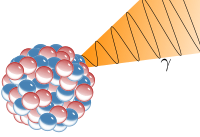
Photo from wikipedia
Interaction of intense radiation from the underlying accretion disc with steady, general-relativistic jet is studied. The radiation field imparts momentum as well as energy on to the outflowing jet under… Click to show full abstract
Interaction of intense radiation from the underlying accretion disc with steady, general-relativistic jet is studied. The radiation field imparts momentum as well as energy on to the outflowing jet under Compton scattering. As a result, the jet gains momentum and is simultaneously heated up. Jets can be classified as types A, B and C according to their base properties. We found that A type jets can undergo shock transition. It is also shown that, in the Compton scattering regime, radiation can drive jets starting with very small thermal energy at the base (B and C type jets). Such that, radiation can even} accelerate bound matter (generalized Bernoulli parameter $E 1$. We also show that for a given disc luminosity, jets in the Compton scattering regime exhibit a minimum terminal speed, unlike in the Thomson scattering domain. Further, the impact of accretion disc luminosity and jet plasma composition is studied. The ${{\rm e}^--{\rm p}^+}$ jets are accelerated up to Lorentz factors of about a few, while for lepton dominated jets the minimum Lorentz factor exceeds $10$ for moderate disc luminosities and can go up to few tens for highly luminous discs.
Journal Title: Monthly Notices of the Royal Astronomical Society
Year Published: 2018
Link to full text (if available)
Share on Social Media: Sign Up to like & get
recommendations!